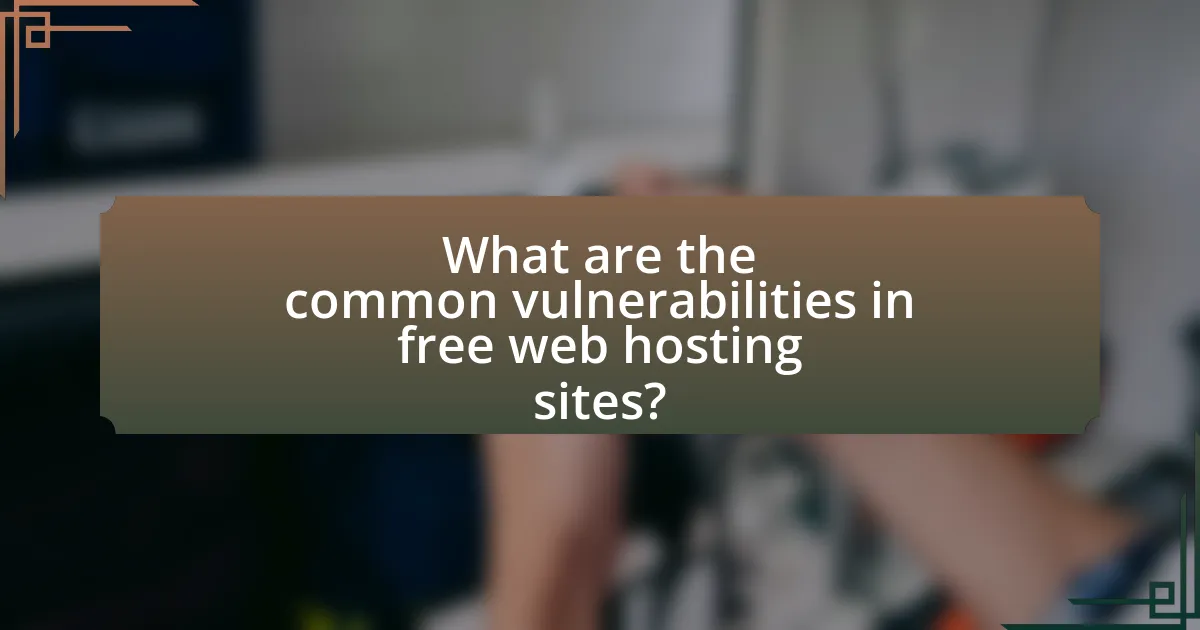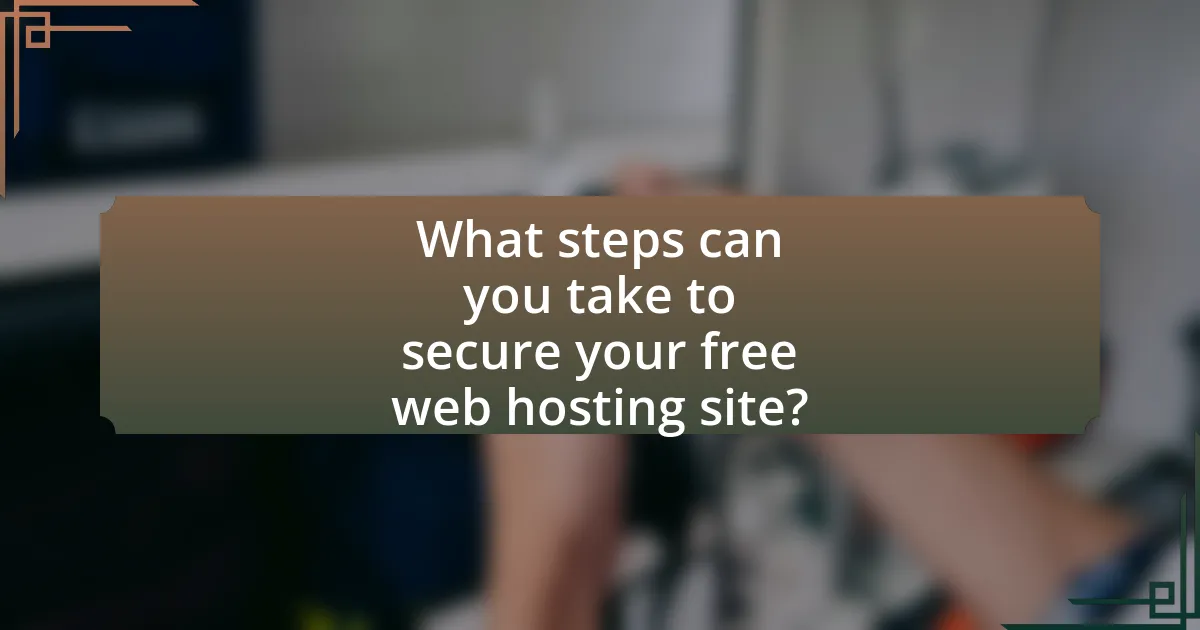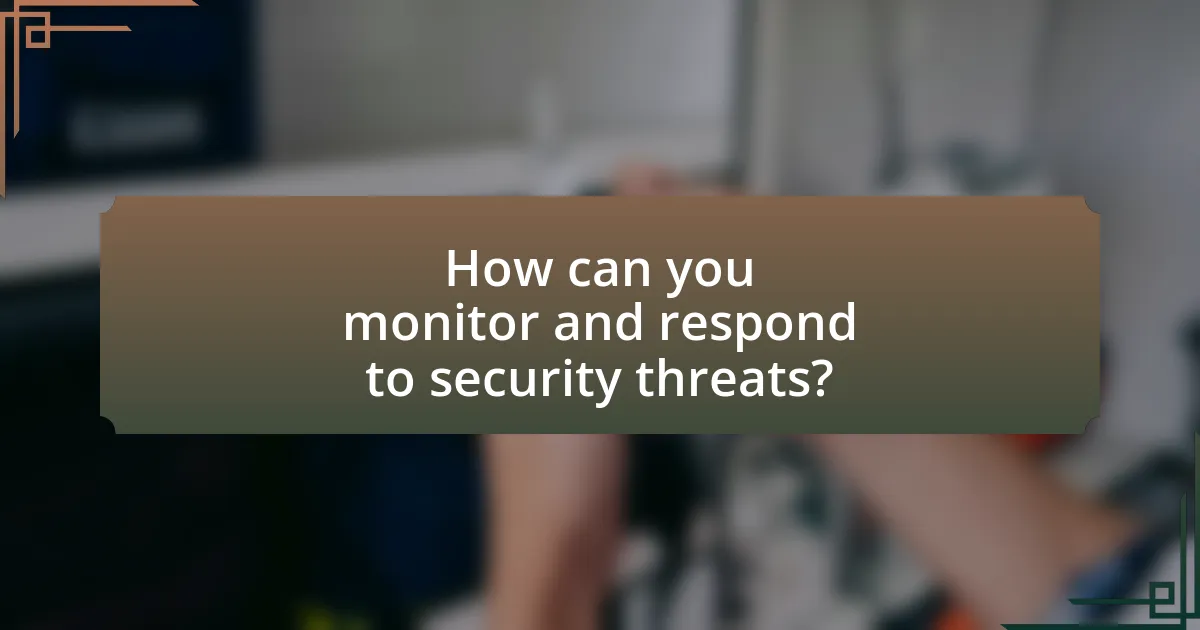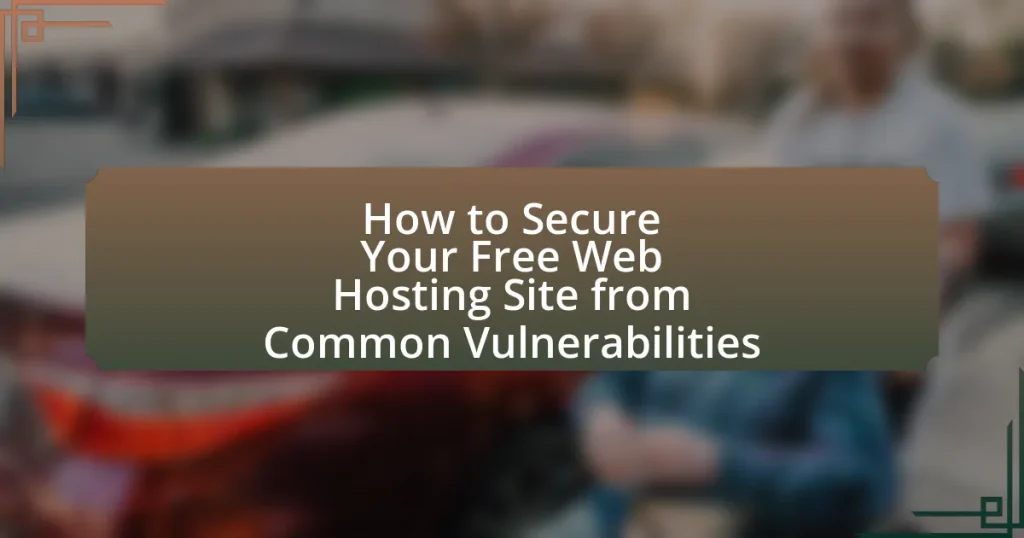The article focuses on securing free web hosting sites from common vulnerabilities that can compromise website security. It identifies prevalent risks such as inadequate security measures, SQL injection, and cross-site scripting (XSS), which can lead to unauthorized access and data breaches. The discussion emphasizes the importance of implementing strong passwords, regular software updates, and HTTPS to mitigate these vulnerabilities. Additionally, it outlines best practices for monitoring security threats and responding effectively to incidents, highlighting the critical need for proactive security management in free hosting environments.

What are the common vulnerabilities in free web hosting sites?
Common vulnerabilities in free web hosting sites include inadequate security measures, lack of regular updates, and shared resources leading to cross-site scripting (XSS) and SQL injection risks. These platforms often do not implement robust security protocols, making them susceptible to attacks. For instance, a study by the Cybersecurity & Infrastructure Security Agency (CISA) highlighted that many free hosting services fail to apply timely security patches, leaving users exposed to known exploits. Additionally, the shared nature of resources in free hosting environments can allow attackers to exploit one site to gain access to others, increasing the risk of data breaches and unauthorized access.
How do these vulnerabilities affect website security?
Vulnerabilities significantly compromise website security by exposing systems to unauthorized access, data breaches, and malicious attacks. For instance, SQL injection vulnerabilities allow attackers to manipulate database queries, potentially leading to unauthorized data access or deletion. According to the 2021 Verizon Data Breach Investigations Report, 39% of data breaches involved web applications, highlighting the critical impact of these vulnerabilities on overall security. Additionally, cross-site scripting (XSS) vulnerabilities can enable attackers to execute scripts in users’ browsers, leading to session hijacking and data theft. Therefore, addressing these vulnerabilities is essential for maintaining robust website security.
What are the most prevalent types of vulnerabilities?
The most prevalent types of vulnerabilities include SQL injection, cross-site scripting (XSS), cross-site request forgery (CSRF), and insecure direct object references. SQL injection allows attackers to manipulate database queries, potentially exposing sensitive data. Cross-site scripting (XSS) enables attackers to inject malicious scripts into web pages viewed by users, compromising their security. Cross-site request forgery (CSRF) tricks users into executing unwanted actions on a web application where they are authenticated, leading to unauthorized transactions. Insecure direct object references occur when an application exposes a reference to an internal implementation object, allowing attackers to access unauthorized data. According to the OWASP Top Ten, these vulnerabilities are consistently ranked among the most critical risks to web applications, highlighting their prevalence and the need for robust security measures.
How can these vulnerabilities be exploited by attackers?
Attackers can exploit vulnerabilities in free web hosting sites through various methods such as SQL injection, cross-site scripting (XSS), and remote file inclusion. For instance, SQL injection allows attackers to manipulate database queries, potentially gaining unauthorized access to sensitive data. Cross-site scripting enables attackers to inject malicious scripts into web pages viewed by users, leading to data theft or session hijacking. Remote file inclusion can allow attackers to execute arbitrary code on the server by including malicious files. These exploitation techniques are well-documented in cybersecurity literature, highlighting the importance of securing web applications against such vulnerabilities to prevent data breaches and unauthorized access.
Why is it important to secure your free web hosting site?
Securing your free web hosting site is crucial to protect sensitive data and maintain user trust. Free web hosting services often lack robust security measures, making them vulnerable to cyberattacks such as data breaches and malware infections. According to a report by Cybersecurity Ventures, cybercrime is projected to cost the world $10.5 trillion annually by 2025, highlighting the increasing risks associated with inadequate security. By implementing security measures, such as using strong passwords and enabling SSL certificates, website owners can significantly reduce the risk of unauthorized access and data loss, thereby safeguarding their online presence and reputation.
What risks do unsecured sites face?
Unsecured sites face significant risks, including data breaches, malware infections, and loss of user trust. These vulnerabilities arise because unsecured sites lack encryption and proper security measures, making them easy targets for cybercriminals. For instance, according to a report by Verizon, 43% of data breaches involve small businesses, often due to inadequate security protocols. Additionally, unsecured sites can be exploited to distribute malware, which can compromise both the site and its visitors. This not only leads to financial losses but also damages the site’s reputation, as users are less likely to engage with a site that has a history of security issues.
How can a security breach impact your website and users?
A security breach can severely compromise your website and users by exposing sensitive data, leading to financial loss and reputational damage. When a breach occurs, attackers can access personal information such as usernames, passwords, and credit card details, which can result in identity theft and fraud. According to a 2020 report by IBM, the average cost of a data breach is $3.86 million, highlighting the financial implications for businesses. Additionally, users may lose trust in your website, leading to decreased traffic and engagement, as 81% of consumers stated they would stop using a brand after a data breach, according to a survey by KPMG. Thus, the impact of a security breach extends beyond immediate financial costs to long-term damage to user trust and brand integrity.

What steps can you take to secure your free web hosting site?
To secure your free web hosting site, implement strong passwords and enable two-factor authentication. Strong passwords reduce the risk of unauthorized access, while two-factor authentication adds an extra layer of security by requiring a second form of verification. Additionally, regularly update your software and plugins to patch vulnerabilities, as outdated systems are prime targets for attacks. Use secure connections, such as HTTPS, to encrypt data transmitted between users and your site, protecting sensitive information from interception. Regularly back up your site to recover from potential data loss due to security breaches. Finally, monitor your site for unusual activity, which can help identify and mitigate threats early.
How can you strengthen your password security?
To strengthen your password security, use complex passwords that include a mix of uppercase letters, lowercase letters, numbers, and special characters. Research indicates that passwords with at least 12 characters are significantly harder to crack; for instance, a study by the National Institute of Standards and Technology (NIST) emphasizes the importance of password length and complexity in preventing unauthorized access. Additionally, enable two-factor authentication (2FA) wherever possible, as it adds an extra layer of security by requiring a second form of verification beyond just the password.
What are the best practices for creating strong passwords?
The best practices for creating strong passwords include using a combination of uppercase letters, lowercase letters, numbers, and special characters, while ensuring the password is at least 12 characters long. This complexity makes it significantly harder for attackers to guess or crack passwords. Research indicates that longer passwords exponentially increase security; for instance, a 12-character password can take billions of years to crack using brute force methods. Additionally, avoiding common words, phrases, or easily accessible personal information, such as birthdays or names, further enhances password strength. Regularly updating passwords and using unique passwords for different accounts also mitigate risks associated with password reuse.
How often should you change your passwords?
You should change your passwords every three to six months. Regularly updating passwords reduces the risk of unauthorized access, especially if a password has been compromised. According to the National Institute of Standards and Technology (NIST), changing passwords frequently can help mitigate security risks associated with data breaches and unauthorized access.
What role does software updates play in website security?
Software updates play a critical role in website security by patching vulnerabilities that could be exploited by attackers. Regular updates ensure that the website’s software, including content management systems, plugins, and server software, is equipped with the latest security enhancements and fixes. According to a report by the Cybersecurity and Infrastructure Security Agency (CISA), 60% of data breaches are linked to vulnerabilities for which patches were available but not applied. This statistic underscores the importance of timely software updates in mitigating risks and protecting sensitive data from unauthorized access.
How can outdated software expose your site to vulnerabilities?
Outdated software can expose your site to vulnerabilities by lacking the latest security patches and updates that protect against known threats. When software is not regularly updated, it becomes an easy target for cyber attackers who exploit these unpatched vulnerabilities. For instance, according to a report by the Ponemon Institute, 60% of data breaches are linked to unpatched vulnerabilities, highlighting the critical need for timely software updates to mitigate risks. Additionally, outdated software may not support modern security protocols, further increasing the likelihood of successful attacks.
What tools can help automate software updates?
Tools that can help automate software updates include WSUS (Windows Server Update Services), SCCM (System Center Configuration Manager), and third-party solutions like ManageEngine Patch Manager Plus and Automox. WSUS allows administrators to manage the distribution of updates released through Microsoft Update to computers in a corporate environment, ensuring that systems remain secure and up-to-date. SCCM provides a comprehensive solution for managing updates across various operating systems and applications, facilitating streamlined deployment and compliance reporting. ManageEngine Patch Manager Plus automates patch management for multiple platforms, while Automox offers cloud-based patch management that simplifies the update process across diverse environments. These tools enhance security by ensuring timely updates, reducing vulnerabilities associated with outdated software.

How can you monitor and respond to security threats?
To monitor and respond to security threats, implement a combination of real-time monitoring tools, regular security audits, and incident response plans. Real-time monitoring tools, such as intrusion detection systems (IDS) and security information and event management (SIEM) solutions, provide alerts on suspicious activities, enabling immediate action. Regular security audits help identify vulnerabilities in your web hosting environment, allowing for proactive measures to be taken. An incident response plan outlines the steps to take when a security threat is detected, ensuring a swift and organized response. According to a 2021 report by Cybersecurity Ventures, organizations that adopt a structured incident response plan can reduce the cost of a data breach by an average of $1.23 million.
What tools are available for monitoring website security?
Tools available for monitoring website security include intrusion detection systems (IDS), web application firewalls (WAF), and security information and event management (SIEM) solutions. Intrusion detection systems, such as Snort, analyze network traffic for suspicious activity and potential threats. Web application firewalls, like Cloudflare and Sucuri, protect websites from attacks by filtering and monitoring HTTP traffic. Security information and event management solutions, such as Splunk and LogRhythm, aggregate and analyze security data from various sources to identify vulnerabilities and respond to incidents effectively. These tools are essential for maintaining the security of websites, especially those hosted on free platforms, where vulnerabilities are more prevalent.
How do these tools detect vulnerabilities and threats?
These tools detect vulnerabilities and threats by employing various techniques such as automated scanning, signature-based detection, and behavioral analysis. Automated scanning tools systematically examine web applications and servers for known vulnerabilities by comparing them against a database of vulnerabilities, such as the Common Vulnerabilities and Exposures (CVE) list. Signature-based detection identifies threats by matching patterns of known malware or attack vectors, while behavioral analysis monitors system behavior to identify anomalies that may indicate a security breach. For instance, tools like Nessus and OWASP ZAP utilize these methods to provide comprehensive assessments of web hosting environments, ensuring that potential security weaknesses are identified and addressed promptly.
What should you do if a security threat is detected?
If a security threat is detected, immediately isolate the affected system to prevent further damage. This action is crucial as it stops the threat from spreading to other systems or networks. Following isolation, conduct a thorough assessment to identify the nature and extent of the threat, which is essential for effective remediation. According to cybersecurity best practices, timely detection and response can reduce the impact of security incidents significantly, as evidenced by studies showing that organizations that respond within the first hour of detection can mitigate damages by up to 80%.
What are the best practices for securing your free web hosting site?
To secure your free web hosting site, implement strong passwords, regularly update software, and utilize HTTPS. Strong passwords reduce the risk of unauthorized access; for instance, using a combination of letters, numbers, and symbols can significantly enhance security. Regularly updating software, including content management systems and plugins, addresses vulnerabilities that could be exploited by attackers. Utilizing HTTPS encrypts data transmitted between the user and the server, protecting sensitive information from interception. According to a study by the Online Trust Alliance, sites using HTTPS are 50% less likely to be compromised compared to those that do not.
How can regular backups enhance your website security?
Regular backups enhance website security by ensuring that data can be restored quickly in the event of a cyber attack, data corruption, or accidental deletion. When a website is compromised, having recent backups allows for the restoration of the site to its previous state, minimizing downtime and data loss. According to a study by the Cybersecurity & Infrastructure Security Agency, organizations that implement regular backup protocols can recover from incidents 50% faster than those without such measures. This rapid recovery capability is crucial for maintaining the integrity and availability of a website, thereby strengthening overall security.
What additional security measures should you consider implementing?
To enhance the security of your free web hosting site, consider implementing measures such as regular software updates, strong password policies, and the use of HTTPS. Regular software updates ensure that any vulnerabilities in the hosting platform or applications are patched promptly, reducing the risk of exploitation. Strong password policies, including the use of complex passwords and two-factor authentication, significantly decrease the likelihood of unauthorized access. Additionally, using HTTPS encrypts data transmitted between the user and the server, protecting sensitive information from interception. These measures are supported by cybersecurity best practices, which emphasize the importance of proactive security management to mitigate risks associated with common vulnerabilities.
